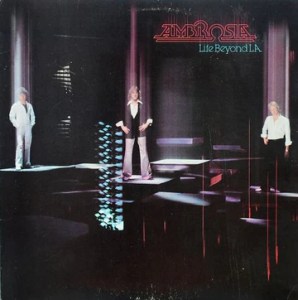AMBROSIA is an album we admit to being obsessed with — just look at the number of commentaries we’ve written about it. It’s also part of our extensive Listening in Depth series. There is no question that this band, their producers and their engineers sweated every detail of this remarkable recording. They went the distance. In the end they brought in Alan Parsons to mix it, and Doug Sax to master it. The result is a masterpiece, an album that stands above all others.
It’s not prog. It’s not pop. It’s not rock. It’s Ambrosia — the food of the gods.
The one album that I would say it most resembles is Dark Side of the Moon. (Note the Parsons connection.) Like DSOTM, Ambrosia is neither Pop nor Prog but a wonderful mix of both and more.
Perhaps hearing Dark Side was what made you realize how good a record could sound. Looking back on it over the last thirty years, it’s clear to me now that this album, along with a handful of others, is one of the surest reasons I became an audiophile, and managed to stick with it for so long. What could be better than hearing music like this sound so good?
Although I didn’t discover the album until some time later in the 90s, I recognized the challenge it presented to my system, setup and room immediately, a subject I write about here. The band’s first album is yet another record the deserves a great deal of credit for helping me become a better listener.
Side One
Nice, Nice, Very Nice
Once you know this record well, you can easily tell if you have a good side one within the first minute of this song. Side one has a tendency to be somewhat bright and even aggressive in places. This problem is further exacerbated by the typical copy’s lack of bass. The best copies have incredibly tight, punchy bass at the beginning of this song, and plenty of it. Phenomenal bass. Demo Disc quality bass.
If that’s not what you hear, you know you will soon be in for more problems. The vocals need to start out smooth, because they get brighter later on. Missing bass or added brightness are sure signs of trouble ahead. The lines “I wanted all things to make sense/ so we’d be happy instead of tense” will be aggressive on copies that are not tonally correct. And copies without tons of bass are not tonally correct, because the recording has tons of bass. It’s essential to the music. Any stereo incapable of providing the power in the lower octaves demanded by this recording is going to make a real mess of this one.
Time Waits for No One
Room shaking deep bass can be heard (and felt!) on the best copies, somewhere in the 20 hertz range. (The deep bass in my house can best be heard in the kitchen; bass seeks the most solid walls that intersect, and that must be where they are, cause it sure sounds good in there.)
Holdin’ on to Yesterday
The big hit off the album. Note the pure-left pure-right guitar-violin duet in the break. Turning your balance knob all the way over gives you one without the other, a neat effect, like sitting at the console and bringing up the fader marked “guitar” or “violin.”
Listen for the distortion on the loudest notes of the guitar; it’s on every copy, which means it’s on the tape.
World Leave Me Alone
Side Two
The number of copies that have a Hot Stamper on side one are somewhat more rare than those with a Hot Stamper for side two. Side two is usually smoother; that smoothness is key to making this record sound right on both sides.
Make Us All Aware
One of my all time favorite songs, in waltz time no less. On this track there is a great deal of musical information, which makes it difficult to reproduce on anything but the best equipment. If you do not have a high quality front end and carefully tweaked system this track will be a mess.
The close-miked harpsichord in the instrumental break is a real tracking test as well.
Lover Arrive
Mama Frog
Amazing drums. If you’ve got a speaker with the kind of piston area that can really move air, the drumming on this track will knock you out.
Drink of Water
Truly the Monster Track of the whole affair, complete with massive church organ and large chorus, all recorded in the kind of cinerama sound that few engineers have ever dreamed of — sound that stretches from wall to wall and floor to ceiling, overflowing with drums, guitars and keyboards of every stripe.
No matter how long you’ve been on this audio journey, twenty weeks or twenty years, this song will present the toughest challenge your system will ever have to face, and that is a fact that will hold true from now until the end of time. It doesn’t get any bigger or any better. Or any tougher.
Systems that can play this kind of musical energy are few and far between, but if you’re lucky enough to have built one, this will be the song that validates your hard work and expense.
Failure certainly is an option. But don’t lose hope. If your system isn’t up to the challenge, this song will guide you in your pursuit of better sound. When this track sounds right, everything else you play will more than likely sound right.







